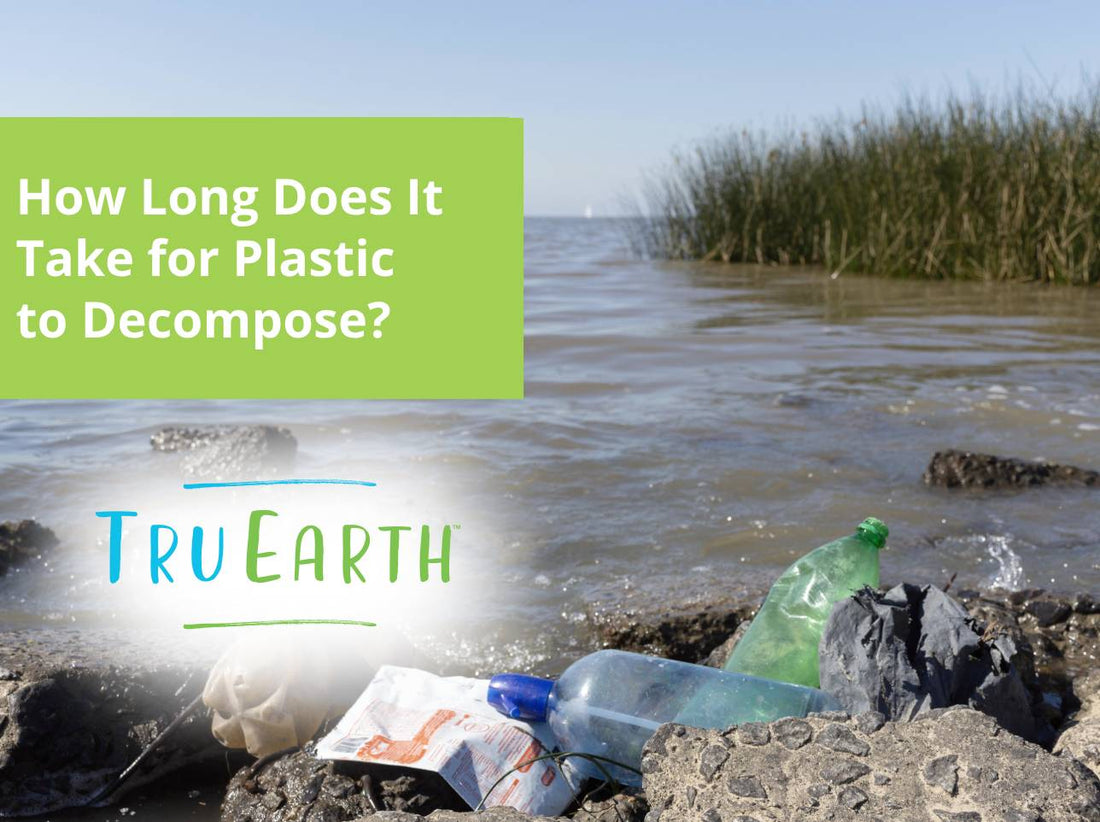Plastic is een integraal onderdeel van ons dagelijks leven, maar de impact ervan op het milieu baart ons grote zorgen. Dit artikel belicht het proces van plasticafbraak en belicht de verschillende factoren die dit proces beïnvloeden.
Aan het eind van dit artikel heeft u een beter beeld van de langetermijneffecten van plastic op onze planeet en wat we kunnen doen om de impact ervan op het milieu te beperken.

De levensduur van plastic
Soorten plastic
Inzicht in de afbraak van plastic begint met kennis van de verschillende soorten plastic. Kunststoffen kunnen grofweg worden onderverdeeld in twee groepen: biologisch afbreekbaar en niet-biologisch afbreekbaar . Biologisch afbreekbaar plastic breekt sneller af, terwijl niet-biologisch afbreekbaar plastic langer blijft bestaan.
Factoren die de ontbinding beïnvloeden
Verschillende factoren spelen een belangrijke rol bij de afbraaktijd van plastic, zoals omgevingsomstandigheden, het type en de grootte van het plastic en blootstelling aan zonlicht.
Biologisch afbreekbare kunststoffen
Snelle ontbinding
Biologisch afbreekbare kunststoffen zijn ontworpen om sneller af te breken dan traditionele kunststoffen. Afhankelijk van het specifieke materiaal en de omstandigheden kunnen ze binnen enkele maanden tot enkele jaren afbreken.
Milieu-impact
Hoewel biologisch afbreekbaar plastic een milieuvriendelijker alternatief biedt, vereisen ze nog steeds specifieke omstandigheden om effectief af te breken. Zonder deze omstandigheden kunnen ze in het milieu aanwezig blijven, zij het korter dan niet-biologisch afbreekbaar plastic.
Niet-biologisch afbreekbare kunststoffen
Verlengde ontledingsperiode
Niet-biologisch afbreekbare kunststoffen, zoals petflessen en plastic zakken, kunnen onder bepaalde omstandigheden eeuwenlang meegaan. Deze kunststoffen zijn dankzij hun moleculaire structuur ongevoelig voor afbraak, waardoor ze zeer duurzaam zijn.
Milieugevolgen
De lange levensduur van niet-biologisch afbreekbaar plastic vormt een ernstige bedreiging voor het milieu. Plasticvervuiling in oceanen, op stortplaatsen en in ecosystemen schaadt dieren in het wild en verstoort natuurlijke processen, met gevolgen die generaties lang aanhouden.
Milieueffecten van plasticvervuiling
Mariene vervuiling
Plastic afval in de oceanen vormt een groeiende crisis. Grote stukken plastic kunnen zeedieren verstrikt raken, wat kan leiden tot verwondingen of de dood. Bovendien worden kleinere plasticdeeltjes, microplastics genaamd , door zeedieren opgenomen, komen in de voedselketen terecht en vormen een gezondheidsrisico voor zowel dieren als mensen.
Bodemvervuiling
Plasticvervuiling op het land tast ecosystemen aan en verstoort de bodemgezondheid. Plastic afval kan eeuwenlang op stortplaatsen blijven liggen, waardoor schadelijke chemicaliën in de bodem terechtkomen en de landbouwproductiviteit wordt beïnvloed.
Luchtverontreiniging
Bij verbranding van plastic komen giftige dampen in de atmosfeer terecht, wat bijdraagt aan luchtvervuiling en klimaatverandering. De verbranding van plastic draagt bij aan de uitstoot van broeikasgassen , wat de milieuproblemen verder verergert.
Ontledingstijden voor gangbare kunststoffen
PET-flessen
PET-flessen ( polyethyleentereftalaat ) hebben wel 450 jaar of langer nodig om te ontbinden op stortplaatsen. Daarmee behoren ze tot de meest hardnekkige soorten plastic afval.
Plastic zakken
Plastic zakken hebben een afbraaktijd van ongeveer 20 jaar bij blootstelling aan lucht en zonlicht. Op stortplaatsen kunnen ze echter eeuwenlang blijven bestaan vanwege het gebrek aan zuurstof en zonlicht dat nodig is voor de afbraak.
Piepschuim
Piepschuim, of geëxpandeerd polystyreen, staat bekend om zijn lage afbraaksnelheid. Het kan wel 500 jaar of langer duren voordat het op de vuilstortplaats is afgebroken.
Plastic rietjes
Het kan 200 jaar of langer duren voordat plastic rietjes vergaan, afhankelijk van de omgevingsomstandigheden.
Het verminderen van de impact van plastic op het milieu
Verminderen en hergebruiken
De eerste stap in het verminderen van plasticvervuiling is het verminderen van plasticgebruik en het omarmen van herbruikbare alternatieven. Door bewust te kiezen voor het minimaliseren van wegwerpplastic, kunnen mensen hun ecologische voetafdruk aanzienlijk verkleinen.
Recycle verantwoord
Goed recyclen helpt voorkomen dat plastic afval op de stortplaats belandt. Maak uzelf vertrouwd met de lokale recyclingrichtlijnen om ervoor te zorgen dat u effectief recyclet. Ondersteun daarnaast initiatieven die recycling en het gebruik van gerecyclede materialen bevorderen.
Ondersteun biologisch afbreekbare alternatieven
Kies voor biologisch afbreekbare kunststoffen en producten indien beschikbaar, omdat deze een lagere milieu-impact hebben. Het is echter essentieel om ervoor te zorgen dat deze biologisch afbreekbare materialen onder de juiste omstandigheden worden afgevoerd om de afbraak te bevorderen.
Doe mee aan opruimacties
Doe mee aan opruimacties in de buurt of op het strand om plastic afval uit het milieu te verwijderen. Bijdragen aan deze initiatieven kan een tastbaar verschil maken in het verminderen van plasticvervuiling.
De rol van innovatie
Bioplastics
Bioplastics zijn in opkomst als een duurzaam alternatief voor traditioneel plastic. Deze materialen zijn ontworpen om biologisch afbreekbaar te zijn en de milieubelasting van plastic afval te verminderen. Hun brede acceptatie en correcte verwijdering zijn echter essentieel voor hun effectiviteit.
Enzymen die plastic eten
Onderzoekers onderzoeken de mogelijkheden van plastic-etende enzymen om plastic afval efficiënter af te breken. Dit veelbelovende onderzoeksgebied heeft de potentie om een revolutie teweeg te brengen in de manier waarop we plasticvervuiling aanpakken.
Circulaire economie
Het implementeren van een circulaire economie omvat het verminderen, hergebruiken en recyclen van plastic producten om hun impact op het milieu te minimaliseren. Door duurzaamheid te prioriteren in productontwerp en consumptiepatronen, kunnen we de productie van plastic afval verminderen.

Het oneindige ontbindingsproces van plastic
De vraag hoe lang het duurt voordat plastic afbreekt, onderstreept de dringende behoefte aan duurzame oplossingen voor plasticvervuiling. Hoewel biologisch afbreekbaar plastic veelbelovend is, vereisen het specifieke omstandigheden om effectief af te breken.
Niet-biologisch afbreekbare kunststoffen daarentegen blijven eeuwenlang bestaan en dragen bij aan de aantasting van het milieu. Inzicht in de milieu-impact van plasticvervuiling stelt ons in staat verantwoorde keuzes te maken en innovaties te ondersteunen die erop gericht zijn de schade veroorzaakt door plastic afval te verminderen. Door onze consumptie te verminderen, verantwoord te recyclen en duurzame alternatieven te omarmen, kunnen we allemaal een bijdrage leveren aan het behoud van onze planeet voor toekomstige generaties.


